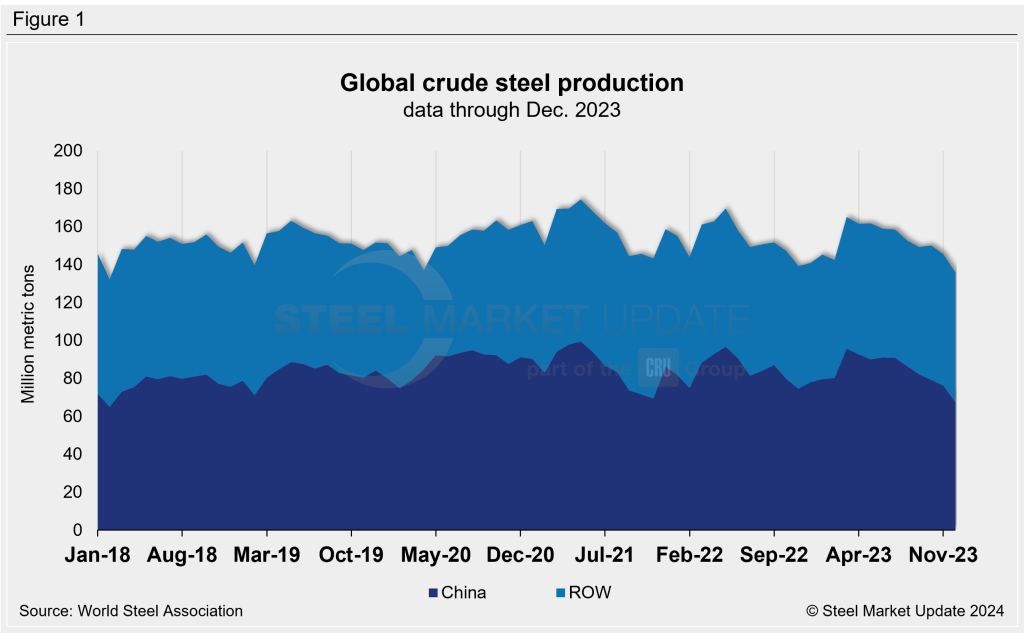Features

Global steel production dipped in December, 2023 output down
Written by David Schollaert
January 25, 2024
Global steel output fell in December, led by cuts in China, the World Steel Association (worldsteel) said in its latest monthly report. Annual totals in 2023 saw a similar trend.
Producers around the world produced 135.7 million metric tons (mt) of steel in December. This was 3.1% below the 145.5 million mt produced the month before and was a 5.3% year-on-year (y/y) decline, worldsteel said.
All told, despite the month-on-month (m/m) decline in global crude steel production last month, output totaled 1.89 billion mt in 2023. The results were largely identical vs. 2022, the report said.
Regional breakdown
China, the world’s top steel producer, saw a 14.9% m/m decline in output to 67.4 million mt in December. China’s production was unchanged y/y, however. December marked the lowest month for Chinese steel production since February 2018.
Meanwhile, steel output in the rest of the world (RoW) declined by 1.6% m/m but was nearly 9% higher y/y to 68.3 million mt in December. For the year, output in the RoW totaled 815.2 million mt in 2023, down 0.5% vs. 2022 when production reached 819.3 million mt.
Regionally, Europe, Other, saw the highest y/y rise in output, increasing by 19.4% y/y to 3.9 million mt. Africa’s production rose by 17.7%; Russia, other CIS, and Ukraine’s by 11.8%; the Middle East’s by 9.6%; and the EU’s was up by 2.7%.
North America’s steel output was up 5.3% y/y in December at 9.3 million mt, but down 1.7% in 2023 vs. the year prior, according to worldsteel’s figures.
Regions with lower on-year production included Asia and Oceania (-9.7% to 96.4 million mt – severely impacted by China’s lower output) and South America (-3.2% to 3.2 million mt).


David Schollaert
Read more from David SchollaertLatest in Features

Final Thoughts
I’m not sure what I can write today that won’t be old news after April 2. The Trump administration has dubbed Wednesday “Liberation Day.” Since it’s mostly about tariffs, let’s just call it “Tariff Day.” Or maybe we should call it “Tariff Week” – since tariffs typically dominate the news cycle in the first week […]

Price on Trade: Auto tariffs, auto parts, and Hyundai – a world of rapid changes
Trump's new auto tariffs will apply to passenger vehicles (including sedans, sport utility vehicles, crossover utility vehicles, minivans, and cargo vans), light trucks, and certain automobile parts (including engines and engine parts, transmissions and powertrain parts, and electrical components).

SMU Steel Summit 2025: Will we see you there?
Anticipation leading up to SMU’s Steel Summit 2025 is already heating up after last year’s record-setting attendance!

Week in Review: March 23-28
The constant flow of information we all receive can be a little overwhelming, but SMU is here to help with a snapshot of the week.

CRU: Canacero urges Mexico-US partnership to fend off Asian steel imports
Victor Cairo, head of Mexico’s steel sector body Canacero and CEO of ArcelorMittal Mexico, says he is confident negotiations between the Mexican and US governments planned for April 2 will lead to the creation of a regional block to substitute imports, especially from Asia.
